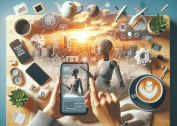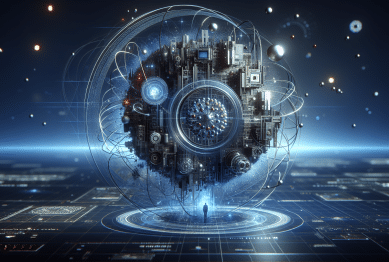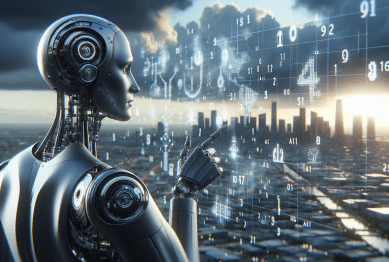Artificial intelligence has quickly become a core part of daily routines, often in ways few notice. Dive into how AI-powered tools shape communication, decision-making, entertainment, finance, and even health, revealing unexpected benefits and considerations linked to emerging tech advancements.
AI-Powered Communication in Your Pocket
Smartphones and messaging platforms have transformed communication patterns. Artificial intelligence works behind the scenes in chat applications, sorting spam, providing language translations, and offering predictive text. These conveniences shape how people connect, with AI-driven voice assistants lending a hand by scheduling reminders or transcribing speech to text in real time. Each text message benefits from machine learning, which predicts words, autocorrects sentences, and helps users communicate with more ease and accuracy. This often happens without users even realizing the depth of AI integration.
Natural language processing (NLP) powers many innovations found in everyday apps and devices. AI understands context, interprets slang, and personalizes interactions, creating informal and more natural communications. Smart assistants, such as virtual helpers, can answer questions by searching online, setting appointments, or reading messages aloud. With such features, barriers are lowered for individuals with visual or motor impairments, fostering inclusivity globally. Increased connectivity enables remote work, learning, and socializing, providing options tailored to individual needs and preferences.
Concerns about data privacy and content moderation have also come to the forefront with these innovations. Machine learning detects harmful content and filters misinformation, aiming for safer digital spaces. Users can access automated customer service bots and see AI-driven recommendations in chat apps. These subtle shifts not only streamline daily routines but also protect users by identifying threats such as phishing or scams. Understanding these changes helps people appreciate how thoroughly AI is woven into their digital conversations.
The Invisible Algorithms Behind Entertainment Choices
Entertainment platforms like music and video streaming services rely on AI to curate personal experiences. Algorithms analyze viewing habits, listen history, and user preferences to recommend content that fits individual tastes. This personal touch saves users time searching for something new, and often introduces them to music, movies, and shows that align with their interests. It’s all about efficiency — but also about widening horizons through unexpected discoveries.
Machine learning not only analyzes browsing and watching history but also predicts what might engage users next. Platforms employ advanced recommendation systems, integrating multiple data points such as time of day, mood, and previous feedback, enhancing user satisfaction. AI-powered recommendation engines help users make choices quickly, making the experience more enjoyable and tailored. For content creators, these systems shape how new material is produced and distributed, offering insights into popular trends and audience engagement.
Advertising and content moderation are subtly managed by AI as well, with algorithms scanning for inappropriate material and ensuring ads are suited to viewer interests. Streaming quality, subtitles, and even translations rely on AI-driven enhancements. Automated editing and content summarization further streamline consumption. As entertainment becomes increasingly algorithmic, it’s important to consider how these systems shape cultural trends and personal tastes, guiding not only what individuals watch or hear, but also how they feel about digital experiences.
Financial Wellness Tools Guided by AI
Financial services harness AI to simplify banking, budgeting, and investment management for consumers. Calculating credit risks, detecting fraud, and automating transactions happen instantly through advanced algorithms. AI helps people monitor spending, receive alerts, and get personalized suggestions to plan for future goals, taking much guesswork out of financial decision-making. Even micro-investments and digital wallets draw on machine learning to predict patterns and offer advice suited to individual financial situations.
Automated trading platforms use AI-powered forecasts to spot trends and execute trades with significant speed, sometimes outpacing traditional methods. Budgeting applications parse receipts and categorize purchases, sending gentle nudges when spending veers off course. These innovations provide accessibility for people without extensive financial backgrounds. They create opportunities for a broader segment of the population to participate in the financial markets or take charge of household budgeting, all with greater ease.
On the safety and regulatory front, AI is instrumental in reducing the risk of error and ensuring compliance with ever-evolving standards. Real-time transaction monitoring guards against illicit activity, while facial recognition and biometric authentication add security layers. By flagging suspicious behavior before it escalates, these tools reinforce trust. The blend of AI with finance continues to grow more sophisticated, from virtual assistants answering banking queries to AI-driven investment robo-advisors managing diversified portfolios.
Smarter Health and Wellness Monitoring
AI is increasingly visible in the health and wellness sphere. Wearable fitness trackers monitor activity, sleep patterns, and even detect heart irregularities, leveraging machine learning to analyze data trends. These devices offer personalized health insights, setting daily goals, suggesting lifestyle improvements, and alerting users to potential health risks based on individualized metrics. Advanced predictive analytics turn raw data into actionable feedback, supporting proactive wellness management for a wide audience.
Healthcare systems, clinics, and hospitals employ AI to expedite diagnosing, monitor vital signs, and analyze imaging scans with remarkable accuracy. Chatbots answer patient queries, suggest possible next steps, and help book appointments seamlessly. Accessibility to telemedicine is boosted as AI interprets symptoms or flags urgent issues for professional assessment. Such technologies lessen wait times and help prioritize cases, particularly in high-demand medical settings. The combination of AI and medical care promises improved outcomes and streamlined service delivery.
Data security and patient privacy remain key considerations in adopting AI health tools. Developers must ensure systems comply with health data protection regulations and support transparency in data use. Ethical questions about automated recommendations and personal health data management are actively being explored. Still, as devices collect more information, the dialogue between human expertise and machine analysis grows richer, offering hope for early detection and guided prevention, from everyday wellness tracking to clinical contexts.
Smart Homes and the Internet of Things (IoT)
Smart homes feature AI at the heart of device connectivity and automation. From smart thermostats adjusting temperatures based on personal schedules, to fridges tracking expiration dates, these systems constantly learn user habits. AI-driven security cameras detect unfamiliar activity, while voice assistants manage home entertainment and lighting with simple commands. Energy efficiency is prioritized, with systems recommending settings that conserve resources, reflecting a blend of convenience and sustainability in daily living.
The Internet of Things has expanded rapidly, with connected devices streamlined by AI for greater interoperability. Homeowners rely on centralized apps to control appliances, secure entrances, and even determine maintenance needs. AI anticipates patterns by learning morning routines, adjusting alarms, and even ordering groceries based on inventory. Through these enhancements, individuals experience unprecedented comfort and remote management opportunities, even when away from home. Seamless integration has made smart living attainable for a growing range of households.
Security and privacy have become top concerns as more devices gather and transmit information. AI-enabled home networks detect threats and patch vulnerabilities proactively. Users benefit from evolving protections that alert them to anomalies, sometimes preventing security breaches or data leaks. Discussions about responsible IoT data practices and digital safety standards are gaining traction as smart technology becomes a foundational part of modern life, illustrating the need for a balance between innovation and user oversight.
AI’s Role in Personalized Learning and Education
Personalized learning harnesses AI to tailor educational content to each learner’s pace and preferences. Adaptive learning systems adjust lesson difficulty, recommend review areas, and provide individualized practice, making it easier for students to absorb complex topics. AI chatbots respond to homework queries quickly, and language learning apps use reinforcement algorithms to keep lessons engaging. Teachers gain insights into class performance, better structuring their instruction based on instant analytics.
Online education platforms, from public universities to informal learning sites, use AI to track progress, detect knowledge gaps, and suggest supplementary resources. The shift to hybrid or remote classrooms leverages video analysis and interaction tracking to keep learners engaged. Automated grading allows educators to focus on personalized coaching, while students receive immediate feedback. This fusion of artificial intelligence and education narrows learning disparities and fosters continuous skill development.
Ensuring accessibility and equity in AI-powered learning tools remains a significant challenge. Some students may face hurdles if lacking reliable internet or digital devices. Education technology companies work to minimize such gaps through mobile-friendly platforms and multilingual support. The adoption of AI also prompts discussion on student data use and ethical learning analytics. Still, the overall effect is a more engaging, efficient, and equitable educational experience, supporting lifelong learning across diverse learner populations.
References
1. National Institute of Standards and Technology. (n.d.). Artificial Intelligence. Retrieved from https://www.nist.gov/artificial-intelligence
2. World Health Organization. (n.d.). Ethics and governance of artificial intelligence for health. Retrieved from https://www.who.int/publications/i/item/9789240029200
3. Stanford University. (n.d.). AI Index Report. Retrieved from https://aiindex.stanford.edu/
4. U.S. Department of Education. (n.d.). Artificial Intelligence and the Future of Teaching and Learning. Retrieved from https://tech.ed.gov/ai/
5. European Union Agency for Cybersecurity. (n.d.). Security and privacy considerations in AI. Retrieved from https://www.enisa.europa.eu/publications/security-and-privacy-in-ai
6. MIT Technology Review. (n.d.). How AI shapes entertainment. Retrieved from https://www.technologyreview.com/2023/03/16/1069891/ai-entertainment/









